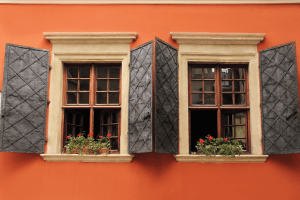We support our Publishers and Content Creators. You can view this story on their website by CLICKING HERE.
 Architects and homeowners have long assumed that the only way to keep houses cool and comfortable is to equip them with central air conditioning.
Architects and homeowners have long assumed that the only way to keep houses cool and comfortable is to equip them with central air conditioning.
However, as electric rates increase, many homeowners are looking for alternatives, especially in very hot climate zones. Some have resorted to so-called passive homes that rely upon massive amounts of insulation, sophisticated ventilation systems, and tight sealing from the outside.
Looking for Natural Options
Not everyone can afford such an expensive option. Thus, architects are looking for more natural means to keep temperatures and expenses down. The Wall Street Journal reported on their surprising findings.
Indeed, they are discovering forgotten natural and architectural techniques that can keep a house cool without air conditioning even when temperatures soar above 100 degrees.
Many of these novel ways to beat the heat are not new at all. Some were very common in the South and other places with hot summers. These traditional ways work just as well today.
Three concepts define these cooling techniques.
Finding the Right Shade
One key concept is shading. Enormous amounts of heat enter through windows, where it is trapped indoors. Traditional builders understood the need to shade windows from sun exposure. They often built covered terraces or second-floor porches to keep the sun away from the windows, resulting in a much cooler house.
Another lost tradition of shading was the use of awnings and shutters. These architectural features kept the sun off the windows and were adjustable so that those inside could open and close them according to the circumstances.
They regulated the light to create moods and ambiences. These charming additions could appear in different models and colors, thus enhancing the beauty of the house.
Architects are rediscovering recessed windows as another means of shading. By keeping windows back, the house façade serves as a shield, and this feature also adds charm and style to the house.
Ventilation Keeps Things Cool
A second traditional concept is ventilation. Traditional houses used ventilation methods that kept things surprisingly cool.
Louisiana homes, for example, would be built on stilts to protect from flooding and allow cooling air to circulate underneath the floors. These same houses would have covered breezeways between houses that would provide both shade and ventilation.
To increase circulation, the attic fan is making a comeback. It draws heat from throughout the house to the attic and forces fresh air in from the windows.
Architects are designing houses with higher ceilings where heat naturally rises. They add higher windows and vents to allow this heat to naturally flow outward. These features also add to the beauty and airiness of the house.
One surprising cooling element that architects propose is the courtyard. An outside courtyard in the middle of the house with small trees, flowers and awnings can provide cool air that can then be drawn indoors. Adding a refreshing fountain in the courtyard can make this feature something enchanting.
Location Is Everything
Perhaps the most important concept for keeping things cool is the positioning of the house. Traditional builders used to look at the patterns of the sun, the prevailing winds and the presence of bodies of water when deciding where to build. This positioning makes houses unique and inviting. It contributes to the comfort and beauty of the house.
It is also very efficient. Lawrence Scarpa, an architect with Cherokee Studios in Los Angeles, says, “If you orient a building properly, you can reduce the heat gain by 50 percent.”
Using all these natural and architectural techniques, builders are constructing houses that do not have air conditioning; they are comfortable almost all the time, even in hot climates.
A Leveling of Housing
While air conditioning has its place in providing comfort, it also has its disadvantages. In a sense, the universal use of air conditioning made all housing equal. It facilitated cookie-cutter housing developments that allowed any house to be put anywhere without regard for shade, ventilation or position. Cooling became a mechanical problem that did not consider place or beauty, but could be installed in identical units in developments without character.
The good news is that modern architects are increasingly looking to the past to find out how homes were designed to deal with heat. They are finding many features, such as awnings, shutters and courtyards, that were not only cool and refreshing but also beautiful.
Architecture should consider not only material living conditions but also the spiritual side. Houses should protect the body and inspire the soul. There is no contradiction between these two functions. As this new housing trend develops, both can find fulfillment.
The Imaginative Conservative applies the principle of appreciation to the discussion of culture and politics—we approach dialogue with magnanimity rather than with mere civility. Will you help us remain a refreshing oasis in the increasingly contentious arena of modern discourse? Please consider donating now.
The featured image is courtesy of Pixabay.
Share This Story, Choose Your Platform!
Go to Top

 Conservative
Conservative  Search
Search Trending
Trending Current News
Current News 





